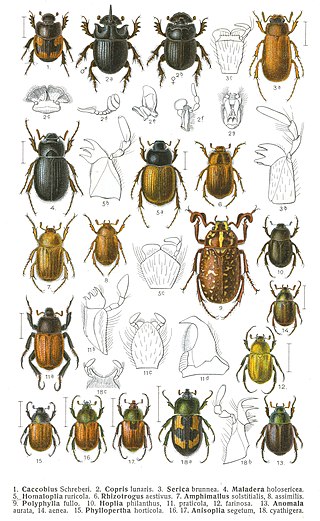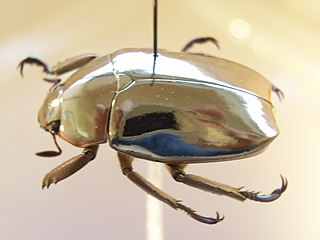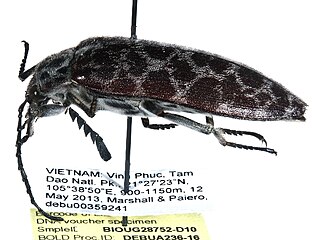
The family Scarabaeidae, as currently defined, consists of over 35,000 species of beetles worldwide; they are often called scarabs or scarab beetles. The classification of this family has undergone significant change. Several groups formerly treated as subfamilies have been elevated to family rank, and some reduced to lower ranks. The subfamilies listed in this article are in accordance with those in Catalog of Life (2023).

Myxophaga is the second-smallest suborder of the Coleoptera after Archostemata, consisting of roughly 65 species of small to minute beetles in four families. The members of this suborder are aquatic and semiaquatic, and feed on algae.

The rain beetles are a group of beetles whose extant species are found only in the far west of North America. They spend most of their lives underground, emerging in response to rain or snow, thus the common name. Formerly classified in the Scarabaeidae, they are currently assigned to their own family Pleocomidae, considered the sister group to all the remaining families of Scarabaeoidea. The family contains a single extant genus, Pleocoma, and two extinct genera, Cretocoma, described in 2002 from Late Cretaceous deposits in Mongolia, and Proteroscarabeus of Late Cretaceous China.

Melolonthinae is a subfamily of the scarab beetles. It is a very diverse group; distributed over most of the world, it contains over 11,000 species in over 750 genera. Some authors include the scarab subfamilies Euchirinae and Pachypodinae as tribes in the Melolonthinae.

Lepicerus is a genus of myxophagan beetles containing three described species in the family Lepiceridae; it is the only extant genus in the family, with another genus, Lepiceratus only known from fossils. Extant species occur in the Neotropics, from Mexico south to Venezuela and Ecuador. Fossils referrable to the genus are known from the early Late Cretaceous of Southeast Asia.

Euchirinae is a subfamily of Scarabaeidae or scarab beetles in the superfamily Scarabaeoidea. They are sometimes referred to as "long-armed scarabs" due to the elongated forelegs of the males. These long legs often have median and apical spines that are fixed in the male while females have a movable terminal spine.

The Brachypsectridae are a family of beetles commonly known as the Texas beetles. There are only two extant genera, Brachypsectra and Asiopsectra. Brachypsectra has a cosmopolitan distribution, mostly in arid regions, while Asiopsectra is found in Central Asia and the Middle East.

Rutelinae or shining leaf chafers is a subfamily of the scarab beetles. It is a very diverse group; distributed over most of the world, it contains some 200 genera with over 4,000 described species in 7 tribes. Several taxa have yet to be described. A few recent classifications include the tribe Hopliini, but this is not generally accepted.
Protognathinus is an extinct genus of stag beetle from the Eocene of Europe, known from the Messel Pit in Germany. This genus is known from the single species P. spielbergi.

Eulichadidae is a family of beetles belonging to Elateriformia. There are two extant genera, Eulichas with several dozen species native to the Indomalayan realm of Asia, and Stenocolus, with a single species native to Western North America. The larvae are aquatic, with the larvae of Eulichas being found in sandy sediments of clean forest streams, while the larvae of Stenocolus are found under rocks and in leaf packs in low elevation streams and rivers. They are herbivious/saprophagous with larval specimens of Eulichas having been found with wood particles in their stomachs, while the larvae of Stenocolus are known to feed on decaying roots and detritus. The adults are terrestrial, with specimens of Eulichas typically found using light, while specimens of Stenocolus are typically found in riparian vegetation, and are not attracted to light. Potential extinct genera have been described from Mesozoic rocks, but the placement of several of these taxa in the family is disputed.
Amblonoxia is a genus of dusty June beetles in the family Scarabaeidae. There are six described species in Amblonoxia.
Gronocarus is a genus of May beetles and junebugs in the family Scarabaeidae. There are at least three described species in Gronocarus.
Podolasia is a genus of May beetles and junebugs in the family Scarabaeidae. There are about 11 described species in Podolasia.
2015 in paleoentomology is a list of new fossil insect taxa that were described during the year 2016, as well as other significant discoveries and events related to paleoentomology that were scheduled to occur during the year.
Holotrichia rufoflava is a species of dung beetle found in South India and Sri Lanka.
Schizonycha ruficollis, is a species of dung beetle found in India and Sri Lanka.

Digitonthophagus bonasus, is a species of dung beetle found in India, Sri Lanka, Pakistan, Nepal, Myanmar, Thailand, Afghanistan, Vietnam and Cambodia.
Gymnopleurus parvus is a species of dung beetle found in India, Sri Lanka and Bangladesh.
Sisyphus crispatus, is a species of dung beetle found in India, Sri Lanka and Pakistan.
Oryctoantiquus is a genus of middle Eocene beetles in the Dynastinae clade. Oryctoantiquus is known for being the oldest known genus of Dynastinae and is also known for being the largest discovered Scarabaeidae so far. The genus only has one known species, O. borealis. The species and genus was found in Oregon, United States and dates from around 44.6 million years to 46.8 million years ago in the Clarno formation, middle Eocene epoch.










